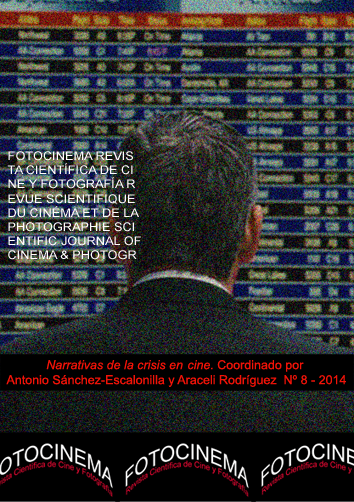La crisis de la postmodernidad: análisis textual de Los mundos sutiles de Chapero Jackson
DOI:
https://doi.org/10.24310/Fotocinema.2014.v0i8.5947Abstract
El cine actual genera imaginarios culturales que producen nuevos modos de mirar el mundo y que replantean su papel en el ámbito sociocultural desde los 90. Sus historias se canalizan mediante la ficción porque no encuentran su sitio en el discurso público o en la racionalidad, interviniendo en la realidad y la identidad individual y colectiva. Cómo interpretar la potencia crítica de estos creadores cinematográficos, su análisis de los problemas sociales o de la crisis postmoderna, se concreta en este artículo con el estudio de la película documental Los mundos sutiles de Eduardo Chapero Jackson sobre el poeta español Antonio Machado. Se trata de reivindicar un cine de calidad en la crisis de la postmodernidad y el postmodernismo cultural, de plantear qué dice el cine sobre el mismo mundo y sobre sí mismo como fenómeno cultural que influye en la percepción de las personas y en la reconfiguración de sus expectativas.
Palabras clave:
Postmodernidad; postmodernismo cultural; postmodernidad cinematográfica; crítica cinematográfica; imaginarios cinematográficos; crisis postmoderna
Keywords:
Postmodernity; cultural postmodernism; cinematographic postmodernity; cinematographic criticism; cinematographic imaginaries; postmodern crisis
Downloads
Metrics
Publication Facts
Reviewer profiles N/A
Author statements
Indexed in
-
—
- Academic society
- N/A
- Publisher
- Universidad de Málaga
Downloads
Published
How to Cite
Issue
Section
License
All contents published in Fotocinema Revista científica de cine y fotografía are protected under the Creative Commons Attribution-NonCommercial-ShareAlike 4.0 International (CC BY-NC-SA 4.0) license. All about this license is available in the following link: <http://creativecommons.org/licenses/by-nc-sa/4.0>
Users can copy, use, redistribute, share and exhibit publicly as long as:
- The original source and authorship of the material are cited (Journal, Publisher and URL of the work).
- It is not used for comercial purposes.
- The existence of the license and its especifications are mentioned.
There are two sets of authors’ rights: moral and property rights. Moral rights are perpetual prerogatives, unrenounceable, not-transferable, unalienable, imprescriptible and inembargable. According to authors’ rights legislation, Fotocinema. Revista científica de cine y fotografía recognizes and respects authors moral rights, as well as the ownership of property rights, which will be transferred to University of Malaga in open access. The property rights are referred to the benefits that are gained by the use or the dissemination of works. Fotocinema. Revista científica de cine y fotografía is published in an open access form and it is exclusively licenced by any means for doing or authorising distribution, dissemination, reproduction, , adaptation, translation or arrangement of works.
Authors are responsable for obtaining the necessary permission to use copyrighted images.














13.png)



